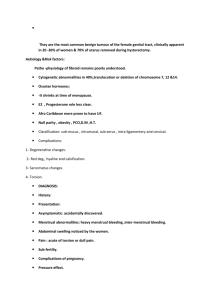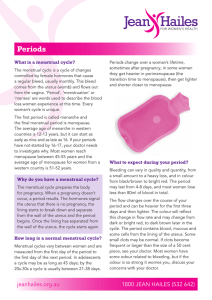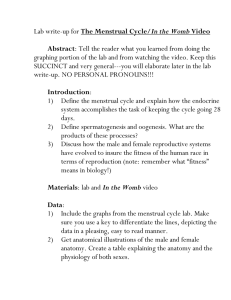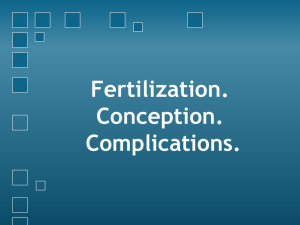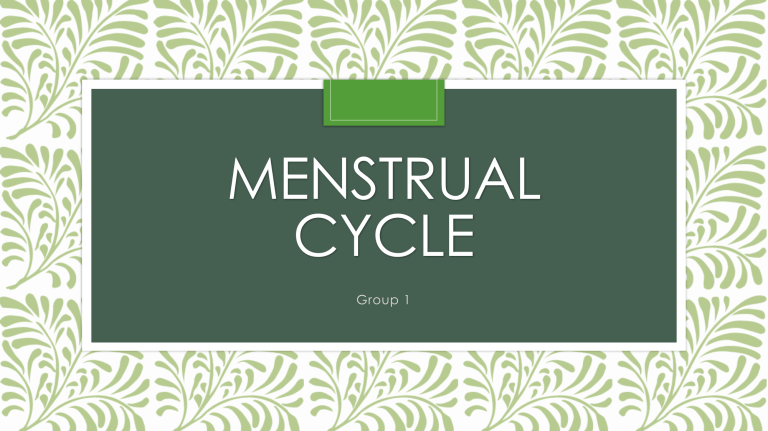
MENSTRUAL
CYCLE
Group 1
Menstrual Cycle
Menstrual cycle is regulated by fluctuating levels of sex hormones
These hormones produce certain changes in the ovaries and uterus
Humans are nearly unique among species in having a menstrual cycle
Other species of mammals have estrous cycles
Basic terms
Endometrium: Lining of the uterus
Oocyte: Developing reproductive cell
Ovum: Mature egg after meiosis
Menopause: Last menstrual cycle, afterwhich egg production stops
4 phases of menstrual cycle
Menstrual flow
Proliferative
Ovulation
Luteal
• Menstruation
• This is the first, but also in some ways the last, phase of your menstrual cycle. It’s when the thickened lining of your uterus sheds during your monthly period. Menstruation can last from three to seven days, depending on the length of your cycle.
• Follicular phase
• This starts on the first day of your menstrual period and ends when you start to ovulate.
During this phase, the egg-containing pods called follicles ripen and one of the eggs matures.
• Ovulation
• This phase happens when the ovary releases that mature egg down the fallopian tube on its way to fertilization. This is the shortest phase of the cycle , lasting just 24 hours.
• Luteal phase
• In this phase, the follicle that released the egg produces hormones that thicken and ripen the uterus to ready it for pregnancy.
During which days of the cycle is FSH at its lowest?
FSH: follicle stimulating hormones is at its lowest during the last days of the cycle
When FSH levels are low what is the size of the follicle
• It is shrinking and disappearing while a new set is growing.
What is happening to estrogen during the follicle phase?
- It dips then rises
- In response the uterus lining dips then rises
Ovulation
Day 14 of the cycle usually marks an event called ovulation
Follicle ruptures open and releases the ripened egg
Pituitary hormones: LH and
FSH are peaking
Estrogen is also released from follicle
Hormones and What Happens in the Ovaries
• Luteal phase - after releasing an egg, the follicle turns into the corpus luteum
– The corpus luteum manufactures progesterone
• Menstruation - shedding of the inner lining of the uterus
Length and Timing of the Cycle
Normal menstrual cycle = 20 to 36 to 40 days; average is about 28 days
– Menstruation begins on day 1 and continues until about day 4 or 5
– Follicular phase extends from about day 5 to about day
13
– Ovulation occurs on day 14
– Luteal phase extends from day 15 to the end of the cycle, day 28
Other Cyclic Changes
Two other physiological processes fluctuate with the menstrual cycle:
– The cervical mucus cycle
– The basal body temperature cycle
Fluctuations in Performance
• Research on intellectual or athletic performance generally shows no fluctuations over the cycle
• Research on academic performance, problem solving, memory, or creative thinking shows no fluctuations over the cycle
What Causes the Fluctuations in
Mood
Biological factors
– Fluctuations in levels of hormones
• Environmental factors
– Menstrual taboos and cultural expectations
Menstrual Cycle
Menstrual Cycle
10 SIGNS YOUR PERIOD
IS ABOUT TO START
•
Abdominal Cramps
•
Breakouts
•
Tender Breasts
•
Fatigue
•
Bloating
• Bowel issues
•
Headache
•
Mood swings
•
Lower back pain
•
Trouble sleeping
•
Treatment
•
Takeaway
MENSTRUAL DISORDERS,
SYMPTOMS, CAUSES &
CURE
Abnormal Uterine
Bleeding
Symptoms:
Menorrhagia
(heavy menstrual bleeding)
Bleeding at unusual times
(between periods, after sex, during menopause)
Unusually long periods
(seven days or longer)
Inconsistent menstrual cycles
Abnormal Uterine Bleeding
(AUB)
Cure/Treatment
Causes
• Medication
• Structural abnormalities in the uterus, including:
• Birth control pills or hormonereleasing intrauterine devices.
• Fibroids (non-cancerous growths of muscle in the uterus)
• Polyps (non-cancerous growths on the lining of the uterus and cervix)
• Uterine fibroid embolization (UFE) . In this minimally invasive procedure guided by an x-ray camera called a fluoroscope, tiny particles are injected through a catheter into uterine arteries that are delivering blood to fibroids, blocking blood flow and causing the fibroids to shrink.
• Uterine cancer
• Cervical cancer
• Blood thinners for anticoagulation
(medications that reduce the risk of blood clots)
• Endometrial ablation . Guided by a narrow lighted tube with a viewing device on the end (called a hysteroscope), the lining of the uterus is destroyed using a laser or other specialized instruments that produce heat, freezing, microwave energy or electrical currents.
• Myomectomy , the surgical removal of fibroids.
• Platelet dysfunction
• Dilation and curettage (D&C) . A procedure in which endometrial tissue is gently scraped or suctioned from the uterus.
• Early pregnancy
• Hormonal changes
• Hysterectomy . A surgical procedure in which the uterus is removed.
Symptoms:
Dysmenorrhea
/Menstrual
Cramps
Aching pain in the abdomen (pain may be severe at times)
Feeling of pressure in the abdomen
Pain in the hips, lower back, and inner thighs
Dysmenorrhea
Causes:
• Menstrual cramps are caused by contractions
(tightening) in the uterus (which is a muscle) by a chemical called prostaglandin. The uterus, where a baby grows, contracts throughout a woman's menstrual cycle.
During menstruation, the uterus contracts more strongly. If the uterus contracts too strongly, it can press against nearby blood vessels, cutting off the supply of oxygen to the muscle tissue of the uterus. Pain results when part of the muscle briefly loses its supply of oxygen.
Cure:
• For best relief, you should take ibuprofen as soon as bleeding or cramping starts. You may take aspirin or another pain reliever such as acetaminophen.
• Place a heating pad or hot water bottle on your lower back or abdomen.
• Rest when needed.
• Avoid foods that contain caffeine .
• Avoid smoking and drinking alcohol .
• Massage your lower back and abdomen.
Premenstrual
Syndrome (PMS)
Symptoms:
Mood swings
Marked anger
Irritability
Tension
Decreased interest in usual activities
Fatigue
Change in appetite
Sleep problems
Physical problems, such as bloating
Premenstrual Syndrome (PMS)
Causes:
• The exact cause of PMS is unknown, but it seems to be related to the fluctuating levels of hormones (including estrogen and progesterone) that occur in preparation for menstruation.
Cure:
• Over-the-counter pain relievers.
• Balanced Diet & Exercise
2 Types of
Amenorrhea
• Primary
• Secondary
Symptoms:
The main sign of amenorrhea is the absence of menstrual periods. Depending on the cause of amenorrhea, you might experience other signs or symptoms along with the absence of periods, such as:
• Milky nipple discharge
• Hair loss
• Headache
• Vision changes
• Excess facial hair
• Pelvic pain
• Acne
Primary:
Amenorrhea (Causes)
Secondary:
• Failure of the ovaries
(female sex organs that hold eggs).
• Problems with hormones secreted by the hypothalamus or the pituitary gland (areas in the brain that make hormones involved in menstruation.
• Poorly formed reproductive organs.
• Pregnancy.
• Breast feeding.
• No longer taking birth control pills.
• Menopause.
• Some birth control methods, such as Depo Provera.
Cure:
• Birth control pills or other types of hormonal medication.
Certain oral contraceptives may help restart the menstrual cycle.
• Medications to help relieve the symptoms of PCOS. ...
• Estrogen replacement therapy (ERT).
Menorrhagia
Symptoms:
• Soaking through one or more sanitary pads or tampons every hour for several consecutive hours
• Needing to use double sanitary protection to control your menstrual flow
• Needing to wake up to change sanitary protection during the night
• Bleeding for longer than a week
• Passing blood clots larger than a quarter
• Restricting daily activities due to heavy menstrual flow
• Symptoms of anemia, such as tiredness, fatigue or shortness of breath
Menorrhagia
Causes:
• Endometrial cancer
• Inflammation or infection of the vagina, cervix, or pelvic organs
• Polyps (small growths on the cervical or uterine wall)
• Thyroid conditions
• Liver, kidney, or blood disease, and the use of blood-thinning drugs
Cure:
• Bed rest may be recommended if bleeding is heavy.
• Record the number of pads or tampons you have used so that your doctor can determine the amount of bleeding.
Change tampons regularly, at least twice a day.
• See your gynecologist if symptoms persist.
DISEASES IN
REPRODUCTIVE
SYSTEM
Endometriosis
• Endometriosis is a problem affecting a woman’s uterus—the place where a baby grows when a woman is pregnant. Endometriosis is when the kind of tissue that normally lines the uterus grows somewhere else. It can grow on the ovaries, behind the uterus, on the bowels, or on the bladder.
Rarely, it grows in other parts of the body.
Symptoms:
Severe menstrual cramps, unrelieved with NSAIDS
( Nonsteroidal antiinflammatory drugs)
Long-term lower-back and pelvic pain
Periods lasting longer than 7 days
Heavy menstrual bleeding where the pad or tampon needs changing every 1 to 2 hours
Bowel and urinary problems including pain, diarrhea , constipation , and bloating
Bloody stool or urine
Nausea and vomiting
Fatigue
Pain during intercourse
Spotting or bleeding between periods
Causes:
1. Problems with menstrual flow
2. Embryonic cell growth
3. Fetal development
4. Surgical scar
5. Endometrial cell transport
6. Genetics
7. Hormones
8. Immune system
Cures:
Surgery
Pain medications
Hormonal Therapies
Fertility Treatment
Uterine Fibroids
• Uterine fibroids are the most common noncancerous tumors in women of childbearing age. Fibroids are made of muscle cells and other tissues that grow in and around the wall of the uterus, or womb. The cause of fibroids is unknown.
Risk factors include being African-
American or being overweight.
Symptoms:
Heavy or painful periods or bleeding between periods.
Feeling “full” in the lower abdomen.
Urinating often.
Pain during sex.
Lower back pain.
Reproductive problems, such as infertility, multiple miscarriages, or early labor.
Causes:
1. Genetic changes
2. Hormones
3. Other growth factors
4. Extracellular matrix (ECM is a threedimensional network of extracellular macromol ecules , such as collagen , enzymes , and glycoproteins , that provide structural and biochemical support of surrounding cells. Because multicellul arity evolved)
Cures:
Gonadotropin-releasing hormone (GnRH) agonists
Progestin-releasing intrauterine device (IUD – a device inserted to the uterus to prevent pregnancy )
Tranexamic acid (Lysteda,
Cyklokapron)
Other medications
Gynecologic
Cancer
• Gynecologic cancer is any cancer that starts in a woman's reproductive organs. Five main types of cancer affect a woman's reproductive organs are cervical, ovarian, uterine, vaginal and vulvar. As a group, they are referred to as gynecologic cancer. A sixth type of gynecologic cancer is the very rare fallopian tube cancer.
Symptoms
Causes:
Reproductive and menstrual history including never having children, starting your menstruation before age 12 and/or going through menopause after age 55
Diabetes
Human papillomavirus (HPV) infection
Smoking
HIV infection or a weak immune system
Obesity
Previous history of breast or gynecologic cancer
Older age
Family history
Use of oral birth control and/or fertility drugs
Estrogen therapy
High-fat diet
Prior radiation to pelvic area
Cures:
Surgeries
Chemotherapies
Radiations
HIV/AIDS
There are 3 stages: stage 1: acute stage , the first few weeks after transmission
stage 2: clinical latency, or chronic stage
stage 3: AIDS
• HIV is the human immunodeficiency virus.
HIV affects specific cells of the immune system (called CD4 cells). Over time, HIV can destroy so many of these cells that the body can’t fight off infection anymore. The human body cannot get rid of HIV—that means once a person has HIV, he or she has it for life. There is no cure at this time, but with proper medical care, the virus can be controlled. HIV is the virus that can lead to acquired immune deficiency syndrome, or
AIDS. AIDS is the late stage of HIV infection, when a person’s immune system is severely damaged.
Causes:
Infected Blood
Sharing drug needles
Unprotected Sex (semen, vaginal fluids)
Breast milk
Sharing tattoo equipments
Oral sex
Contact between open wounds/ skin
Etc.
Cure:
There is no cure for HIV, although antiretroviral treatment can control the virus, meaning that people with HIV can live long and healthy lives.
Most research is looking for a functional
cure where HIV is reduced to undetectable and harmless levels in the body permanently, but some residual virus may remain.
Other research is looking for a sterilising
cure where HIV is eradicated from the body completely, but this is more complex and risky.
Trials of HIV vaccines are encouraging, but so far offer partial protection only.
Interstitial Cystitis
• Interstitial cystitis (IC) is a chronic bladder condition resulting in recurring discomfort or pain in the bladder or surrounding pelvic region. People with IC usually have inflamed or irritated bladder walls that can cause scarring and stiffening of the bladder. IC can affect anyone; however, it is more common in women than men.
Symptoms:
Abdominal or pelvic mild discomfort.
Frequent urination.
A feeling of urgency to urinate.
Feeling of abdominal or pelvic pressure.
Tenderness.
Intense pain in the bladder or pelvic region.
Severe lower abdominal pain that intensifies as the urinary bladder fills or empties.
Causes:
Defects in the lining of the urinary bladder that cause irritation.
Bladder trauma or overstretching.
Pelvic floor muscle dysfunction.
Autoimmune disorders.
Primary neurogenic inflammation.
Spinal cord trauma.
Genetics.
Allergy.
Cures:
Lifestyle changes
Bladder training
Physical therapy
Medicines
Bladder procedures
Polycystic Ovary Syndrome (PCOS)
• Polycystic ovary syndrome happens when a woman’s ovaries or adrenal glands produce more male hormones than normal. One result is that cysts (fluid-filled sacs) develop on the ovaries. Women who are obese are more likely to have
PCOS. Women with PCOS are at increased risk of developing diabetes and heart disease.
Symptoms: Causes:
• Infertility.
• Pelvic pain.
• Excess hair growth on the face, chest, stomach, thumbs, or toes.
• Baldness or thinning hair.
• Acne, oily skin, or dandruff.
• Patches of thickened dark brown or black skin.
• Genes
• Insulin resistance
• Inflammation
Cure:
• Lifestyle change
• Combination birth control pills
• Progestin therapy
• Etc.
Sexually Transmitted Diseases (STDs)
• STDs are infections that you can get from having sex with someone who has the infection. The causes of STDs are bacteria, parasites, and viruses. There are more than
20 types of STDs.
• Most STDs affect both men and women, but in many cases the health problems they cause can be more severe for women. If a pregnant woman has an STD, it can cause serious health problems for the baby.
Symptoms: Causes:
Sores or bumps on the genitals or in the oral or rectal area
Painful or burning urination
Discharge from the penis
Unusual or odd-smelling vaginal discharge
Unusual vaginal bleeding
Pain during sex
Sore, swollen lymph nodes, particularly in the groin but sometimes more widespread
Lower abdominal pain
Fever
Rash over the trunk, hands or feet
The germs that cause STDs hide in semen, blood , vaginal secretions, and sometimes saliva . Most of the organisms are spread by vaginal, anal, or oral sex, but some, such as those that cause genital herpes and genital warts, may be spread through skin contact. You can get hepatitis B by sharing personal items, such as toothbrushes or razors, with someone who has it.
Cure:
Abstain
Stay with one uninfected partner
Wait & test
Get vaccinated
Use condoms and other protective items.
Don't drink alcohol excessively or use drugs
Communicate
Consider male circumcision
Etc.
Keeping the Reproductive System
Healthy
• Eat a balanced diet that is high in fiber and low in fat.
• Drink plenty of water.
• Get regular exercise.
• Maintain a healthy weight.
• Get enough sleep.
• Avoid using tobacco, alcohol, or other drugs.
• Manage stress in healthy ways.
• Use condoms or any other object that can and will protect you from being pregnant and having STDs

